How do you solve a problem like the National League?
- Published
- comments
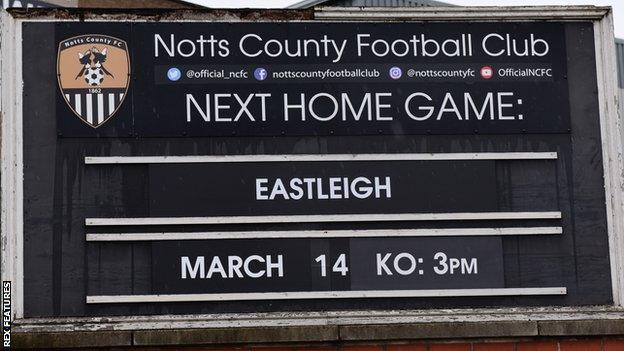
The last round of fixtures in the National League took place on 14 March
How do you solve a problem like the National League?
The coronavirus pandemic has meant the top level of non-league football, as well as its feeder leagues covering the north and south of England, have been called off.
But how do you decide who finishes where, who gets a coveted place in the English Football League and who drops down a division?
The National League board met on Friday to discuss the next steps, but with clubs being consulted a final decision is unlikely to be quick.
In the meantime, BBC Sport has taken a look at some of the possible options...
How they stand
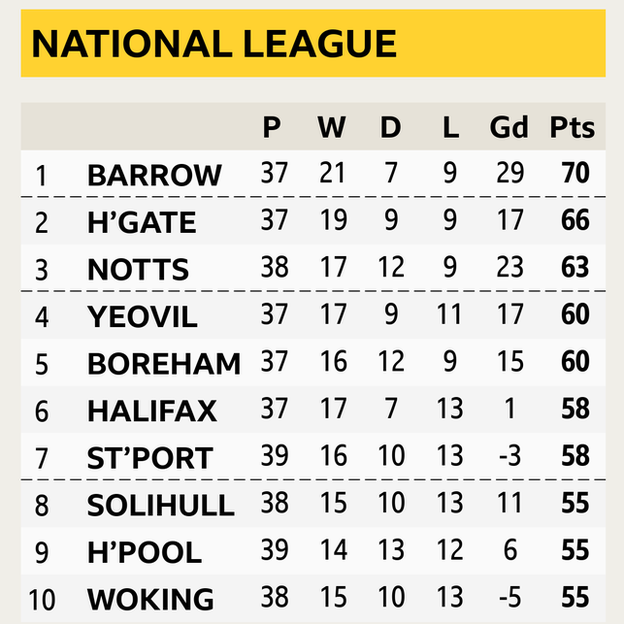
This is how the table looked when the league was suspended on 16 March
When the National League suspended fixtures on 16 March, Barrow had a four-point lead at the top in the sole automatic promotion place.
Second-placed Harrogate Town were three points above third-placed Notts County who had played an extra game.
Yeovil Town, Boreham Wood, FC Halifax Town and Stockport County occupied the remaining play-off places and the four sides were separated by just two points.
Further back were Solihull Moors, Hartlepool United and Woking, while Barnet in 11th had played just 35 games - two fewer than most of the sides in the top six and up to four less than some of the teams immediately above them.
It was probably not unreasonable to say anyone down to Torquay in 15th still had a chance of a late promotion push.
Average points
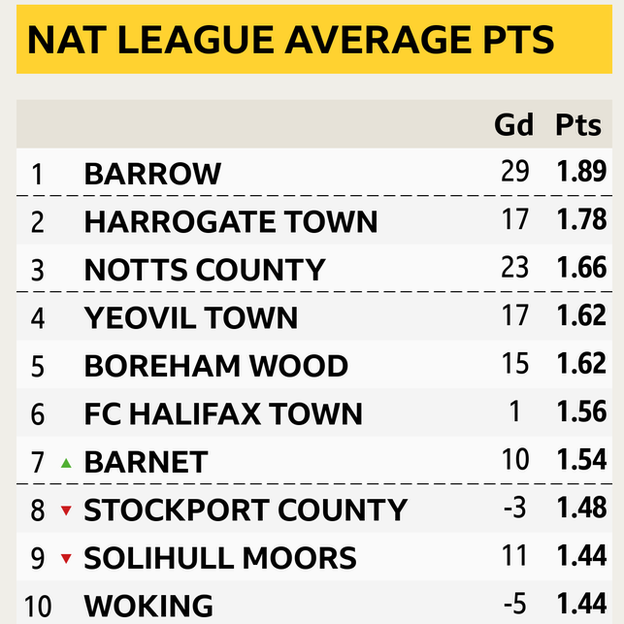
Barnet would move into the play-offs
On the face of it taking the average number of points each team has won from the games they have played would seem a fair way to end the season.
It is a relatively simple system to devise - divide the number of points a team has won by the number of games they have played and rank each side by that figure.
But this system does not take into account the games you have left to play, or indeed the strength of the sides you still have to meet.
Earlier this week Scottish junior side Auchinleck Talbot won their league using this system despite being third when it was called off, a full 12 points behind the leaders.
In this scenario the top six do not change, but Barnet sneak into the play-off places by 0.06 of a point ahead of Stockport County, mainly by virtue of the games they have in hand - very similar to the example in Scotland.
Make the rest of the games 0-0
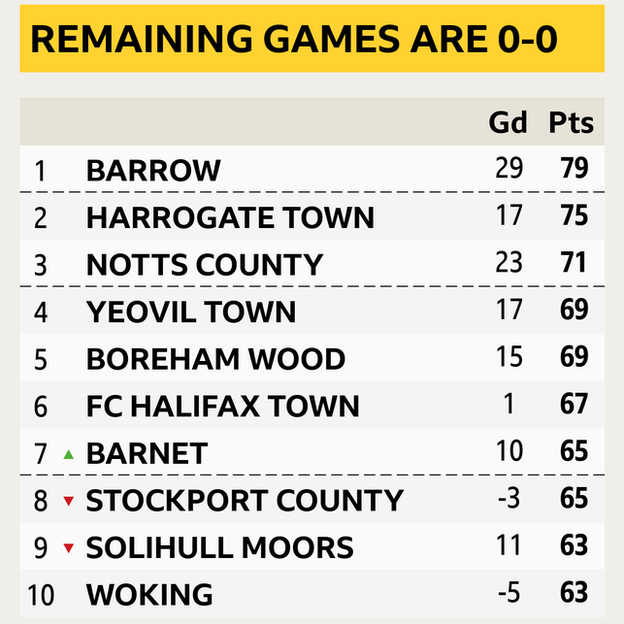
Barnet and Stockport would swap places once again
How about every game not played is declared a goalless draw?
It seems reasonable as technically that is what has happened - neither side has scored a goal - due in this case to neither team being allowed to turn up and play.
In this scenario, Barnet edge the final play-off place on goal difference with Stockport dropping to eighth, but the top six stays the same.
Play each other once
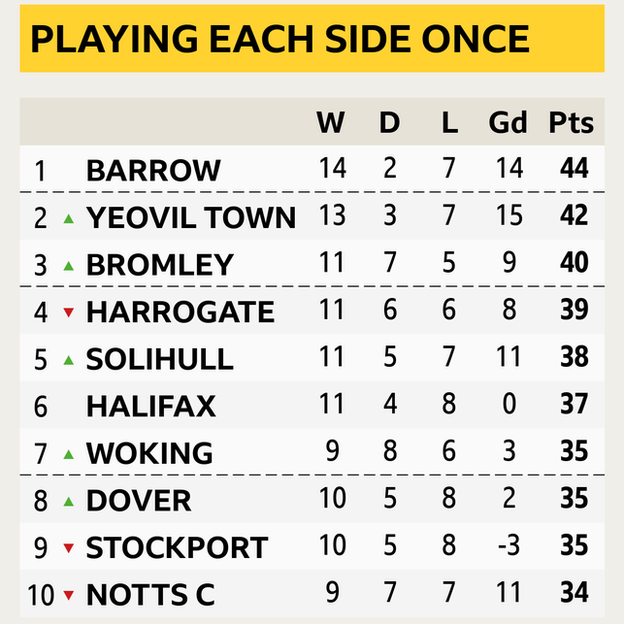
Yeovil and Bromley would be the main benefactors of this scenario
Of course, the problem with both of the examples above is that teams have not played everybody else an equal number of times.
Fifth-placed Boreham Wood only had one side in the top half of the table left to play and still had to face five of the bottom seven sides. So would they have a better chance of picking up more points than a side like Stockport who still have to pay all of the top four?
How about a table based on each side playing each other just once?
To do this the results for the first scheduled fixture between each side are used - most of which took place before the end of November.
So for example although Boreham Wood's Boxing Day trip to Barnet was postponed, rather than use what would have been the return fixture on New Year's Day the result from the rearranged first fixture which was played on 3 March, a 2-2 draw, is recorded.
On the face of it this would seem fairer as each side has played the same number of games and played the same teams.
But it means almost every game played from December 2019 onwards is discounted while sides who may have strengthened as the season has gone on, had influential players return from injury or had a new manager take over and improve fortunes are not accounted for.
It could also be argued that it is not fair for sides who may have played more away games than home games, and what about those who may or may not have had long away trips?
For example Harrogate lost 4-2 on their longest away trip to Torquay in this period, but had they played the game at Wetherby Road, their 2-1 win over the Gulls in Yorkshire would had counted.
What this table does do is throw up a couple of interesting scenarios.

Barrow boss Ian Evatt said it would be "harsh" if his side did not get promoted to League Two
First, Barrow are still top, further strengthening manager Ian Evatt's claims that his side should return to the English Football League.
After playing each of the other 23 teams, Yeovil were second, up from fifth, while Bromley were third - they were 13th when the season was ended.
Harrogate slip to fourth, and Solihull and Woking make the play-off places, either side of Halifax.
Notts County, who won nine and lost just two of their 14 games between 21 December and when the league was halted, only just scrape into the top 10 while Dover - 12th when the season was stopped - are eighth.
Predicting future results
Despite Evatt's claims that Barrow should go up, it could be argued by Harrogate that the title was still in their hands.
They still had to host Barrow in their 41st game and a win could have cut the gap to a single point with six games to play, although the Yorkshire side still had to travel to third-placed Notts County.
But add to that the fact that Barrow still had to face four of the top seven in their final nine games, as well as Barnet who had eyes on the play-offs and Wrexham and Chesterfield who were both fighting to avoid relegation - and it would be very unlikely that the men from Holker Street would take maximum points from every fixture.
On the other side Boreham Wood's only game against a side in the top half was a home fixture against Halifax, so their fans could argue they could easily haul back some of the 10 points they trailed Barrow by, and perhaps make the top three and secure an more favourable play-off draw.
And what about Notts County? They were on a run of four successive victories when the league was halted and would have fancied their chances of keeping that run going.
The truth is, it will never be known.
But it is fair to say that Barrow are top on any of the above measures, while at the other end of the table the bottom four remain the same based on average points and playing every game with a 0-0 draw, while bottom side Chorley prop up the table on pretty much any measure used.
What happens now?
The National League are yet to say how they will decide promotion and relegation.
Barrow boss Evatt said he felt his side not being promoted would be 'harsh' and the numbers seem to agree.
So does the league promote two sides or does just one side go up to League Two to replace the void left by Bury?
Do the play-offs still happen and if so how and who qualifies?
With players' contracts starting to run out what sort of sides could clubs field when restrictions are eased? Even if restrictions are eased, would the games be played in front of fans or would they be behind closed doors?
Could the play-offs be a tournament held at one locked-down venue? Or would there still be potentially long away trips for sides and the fear of spreading the virus?
What about relegation? Apart from Chorley the other sides in the relegation places still had realistic mathematical chances of staying up.
The answers are not easy, and this is just one league - if others leagues have to follow they too will have to decide how best to end a season which has not seen teams play an even number of games.
One thing is for sure - some teams will lose out, while others will be better off.